A Satirical View of Early Flight: Wiener Werkstätte Postcards by Moriz Jung

Left: Moriz Jung (Austrian [born Czechoslovakia], 1885–1915). Tête á Tête on the 968th Floor of a Skyscraper (Tête á Tête am Wolkenkratzer 968 Etage), 1911. Color lithograph; 5 1/2 x 3 9/16 in. (14 x 9 cm). The Metropolitan Museum of Art, New York, Museum Accession, transferred from the Library (WW.340). Right: Moriz Jung (Austrian [born Czechoslovakia], 1885–1915). Bloodless Giraffe Hunt (Unblutige Jagd auf Giraffen), 1911. Color lithograph; 5 1/2 x 3 9/16 in. (14 x 9 cm). The Metropolitan Museum of Art, New York, Museum Accession, transferred from the Library (WW.339)
«Architect Josef Hoffman, painter Koloman Moser, and textile industrialist Fritz Waerndorfer founded the Wiener Werkstätte (Vienna Workshop) in 1903 as a cooperative for artists and artisans. The Wiener Werkstätte began publishing postcards in 1907 and continued until the beginning of World War I. The postcards were among the least expensive or luxurious of the Wiener Werkstätte's products, which included furnishings for the homes of Viennese aristocrats. Most of the designs were intended solely for the postcard format, while a few were reproductions of earlier paintings.»
Picture postcards as we know them today emerged in the mid-nineteenth century and by the late 1890s were considered to be collector's items. The Wiener Werkstätte postcards, particularly due to their uniqueness, were no exception; they were sought by collectors even during the years of their production. In 1965, The Metropolitan Museum of Art was able to purchase an album containing 800 of the 925 postcards produced by the Wiener Werkstätte. This collection of postcards is among the most complete in the United States, making the Metropolitan one of the most important repositories for this material.
Professors at the Kunstgewerbeschule (School of Applied Arts) in Vienna were involved in the design of a variety of products at the Wiener Werkstätte. They both designed for the series of postcards themselves and enlisted the help of their students, many of whose names have been lost. We know particularly little about the designers of the lower-quality cards and those that are unsigned. There is at least one student, however, who thrived in the Wiener Werkstätte.
Moriz Jung studied at the Kunstgewerbeschule from 1901 to 1908 and began contributing designs for Wiener Werkstätte postcards in 1907 while still a student. In his distinctive, thick-lined, graphic style, Jung created several series with a variety of subjects, including dogs and café interiors. He also created caricatures of smokers, four-panel comics, and satires of early airplanes.

Left: Moriz Jung (Austrian [born Czechoslovakia], 1885–1915). The Aeroplegasus (Anzani Engines) (Der Aeroplegasus (Motor Anzani), 1911. Color lithograph; 5 1/2 x 3 9/16 in. (14 x 9 cm). The Metropolitan Museum of Art, New York, Museum Accession, transferred from the Library (WW.341). Right: Moriz Jung (Austrian [born Czechoslovakia], 1885–1915). The Duke of Gramatneiss's Famous Pack of Birds (Die Berühmte Vogelmeute des Herzogs von Gramatneiss), 1911. Color lithograph; 5 1/2 x 3 7/16 in. (14 x 8.8 cm). The Metropolitan Museum of Art, New York, Museum Accession, transferred from the Library (WW.344)
Jung's series on flight, printed in 1911, is among his most memorable. The six satirical prints poke fun at early aviation. Though Jung was not the first artist to treat this subject matter, his images are bright and playful, and they hint at the somewhat dark Viennese sense of humor (a characteristic highlighted by other Wiener Werkstätte postcards as well).
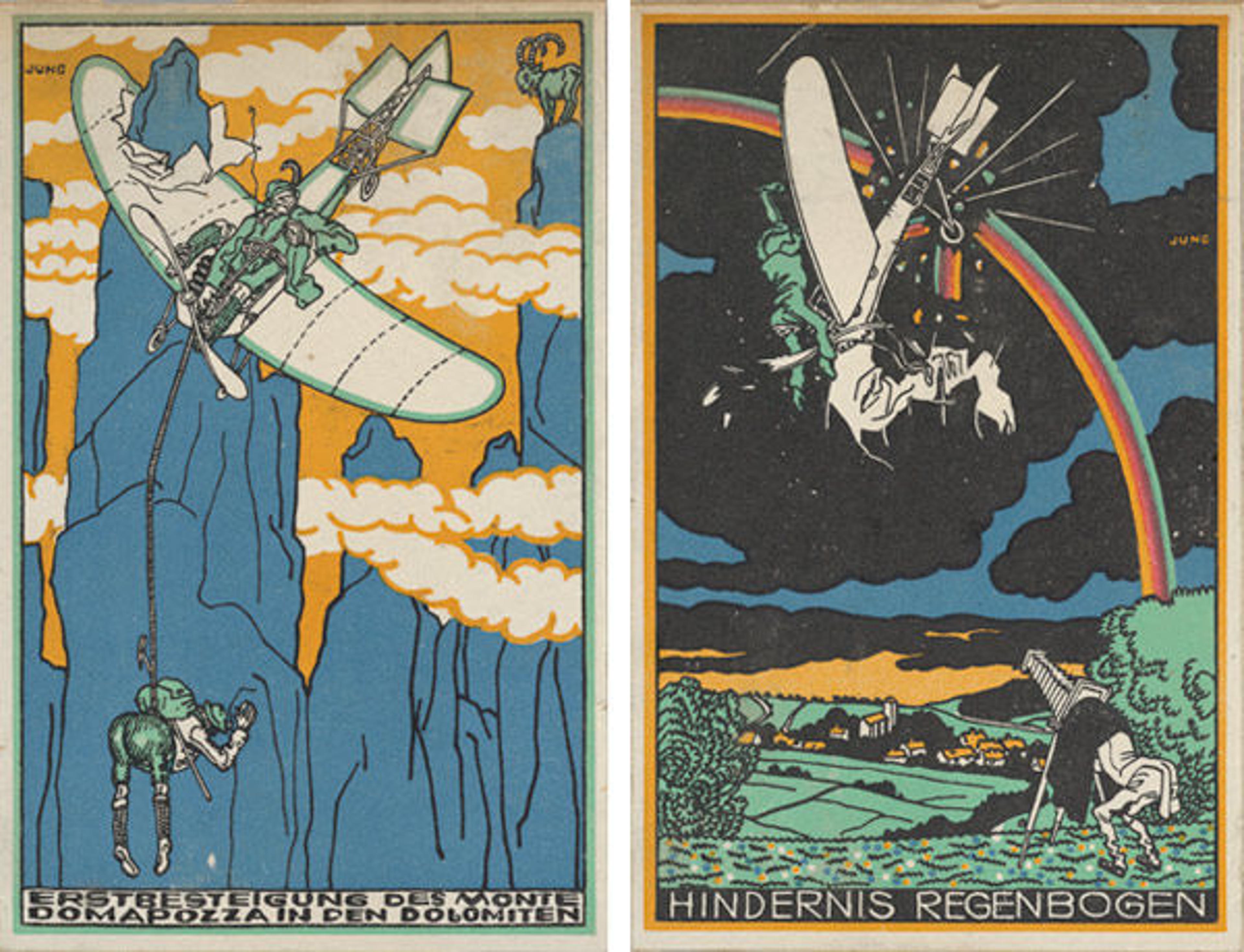
Left: Moriz Jung (Austrian [born Czechoslovakia], 1885–1915). First Ascent of Monte Domapozza in the Dolomites (Erstbesteigung des Monte Domapozza in den Dolomiten), 1911. Color lithograph; 5 1/2 x 3 9/16 in. (14 x 9 cm). The Metropolitan Museum of Art, New York, Museum Accession, transferred from the Library (WW.343). Right: Moriz Jung (Austrian [born Czechoslovakia], 1885–1915). Rainbow Obstacle (Hindernis Regenbogen), 1911. Color lithograph; 5 1/2 x 3 9/16 in. (14 x 9 cm). The Metropolitan Museum of Art, New York, Museum Accession, transferred from the Library (WW.342)
Jung's planes are based on real aircraft of the time. Tête à Tête on the 968th Floor of a Skyscraper is a reference to the French pilot M. Blériot, who made the first flight in an aircraft across the English Channel in 1909. The construction of the plane in this print and in Bloodless Giraffe Hunt looks similar to Blériot's plane as depicted in a trading card published by the Philadelphia Caramel Company (1910). The wings of the planes in the Aeroplegasus (Anzani Angines) and The Duke of Gramatneiss's Famous Pack of Birds look more like those of birds than in the other prints. For Aeroplegasus, this makes sense, as his mechanized flying horse is entirely fanciful.

Bleriot, Monoplane, from the Airships series (E40) issued by the Philadelphia Caramel Company, 1910. Commercial color lithograph; 1 1/2 x 2 5/8 in. (3.8 x 6.7 cm). The Metropolitan Museum of Art, New York, The Jefferson R. Burdick Collection, Gift of Jefferson R. Burdick (Burdick 314, E40.3)
Planes were not used in combat before World War I. The jovial nature of Jung's cards, particularly of Bloodless Giraffe Hunt, makes clear that these early planes were not yet associated with war, despite the fact that a British officer named General John Money had realized the tactical advantages of flight for combat over a century earlier; in 1803, he wrote Treatise on the Use of Balloons, the first treatise on military ballooning. General Money had become interested in balloons after returning from the American Revolutionary War. William Sherlock's lithograph Major Money Adrift in the North Sea illustrates an incident in which a strong wind swept Money's balloon into the North Sea. Jung's First Ascent of Monte Domapozza in the Dolomites and Rainbow Obstacle also depict crashes due to natural causes.
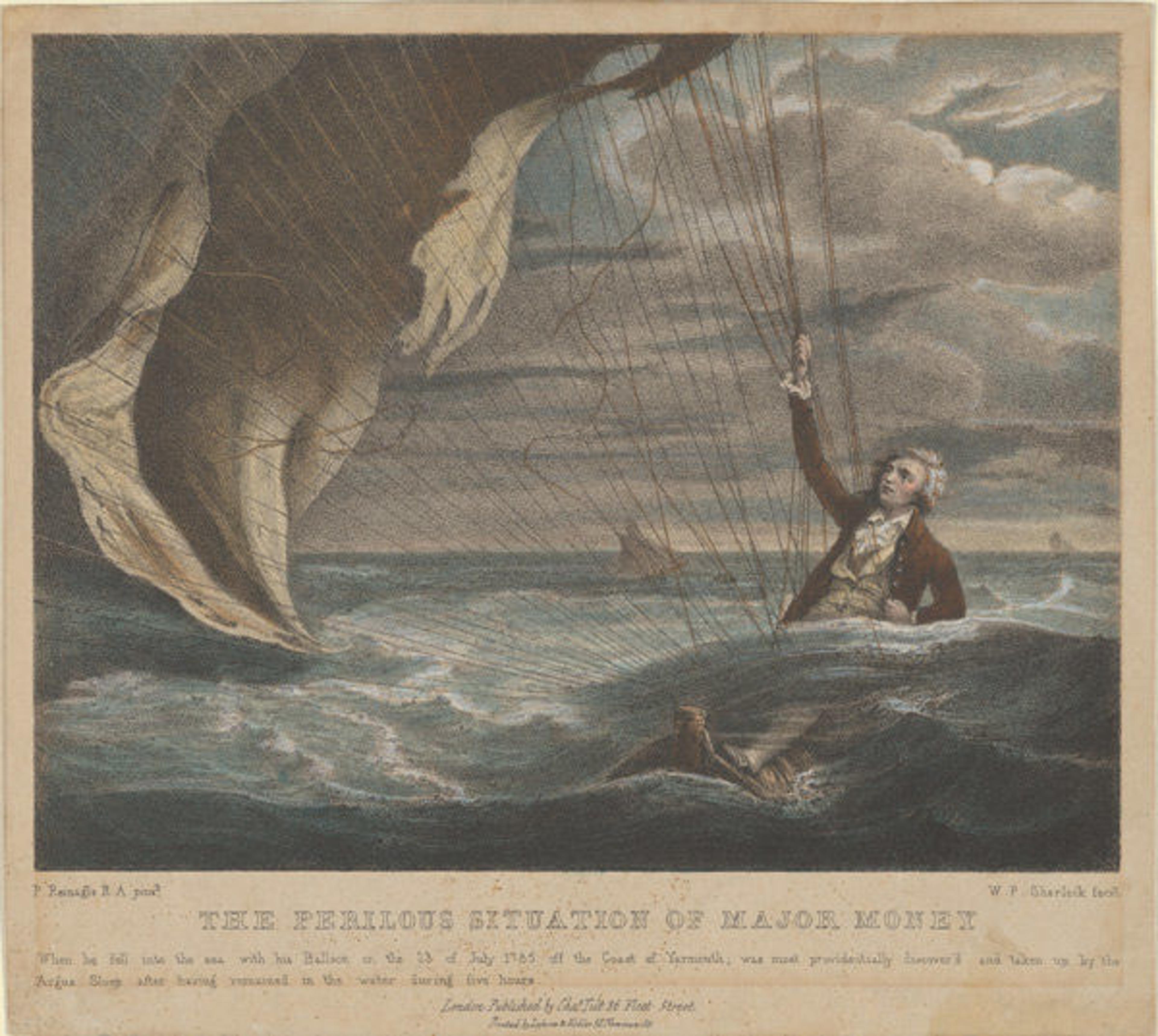
William P. Sherlock (British, 1770–1821). Major Money Adrift in the North Sea, early 19th century. Lithograph with hand coloring; 7 5/16 x 8 3/16 in. (18.6 x 20.8 cm). The Metropolitan Museum of Art, New York, Gift of Paul Bird, Jr., 1962 (62.696.57)
Predecessors of Jung's satirical plane prints were published around 1800. The Flying Philosopher and its accompaniment, The Walking Philosopher, mocked the idea of personal flight. Versions of the images were published in The Entertaining Magazine, Or, Polite Repository of Elegant Amusement (1813) and The Family Magazine (Vol. 1, 1843).
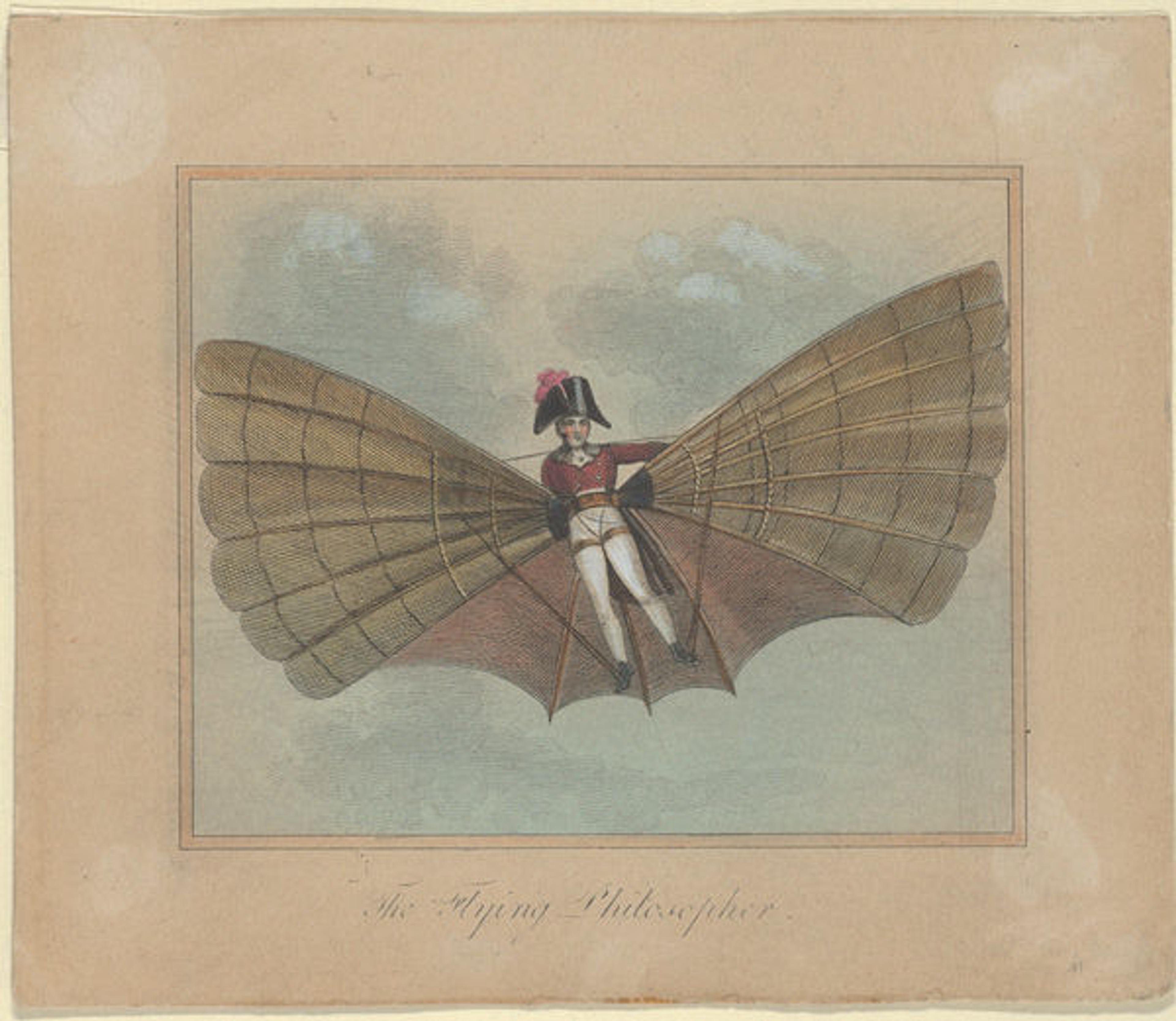
The Flying Philosopher, ca. 1800. Etching with hand coloring; 4 1/4 in. x 5 in. (10.8 x 12.8 cm). The Metropolitan Museum of Art, New York, Gift of Paul Bird, Jr., 1962 (62.696.22a)
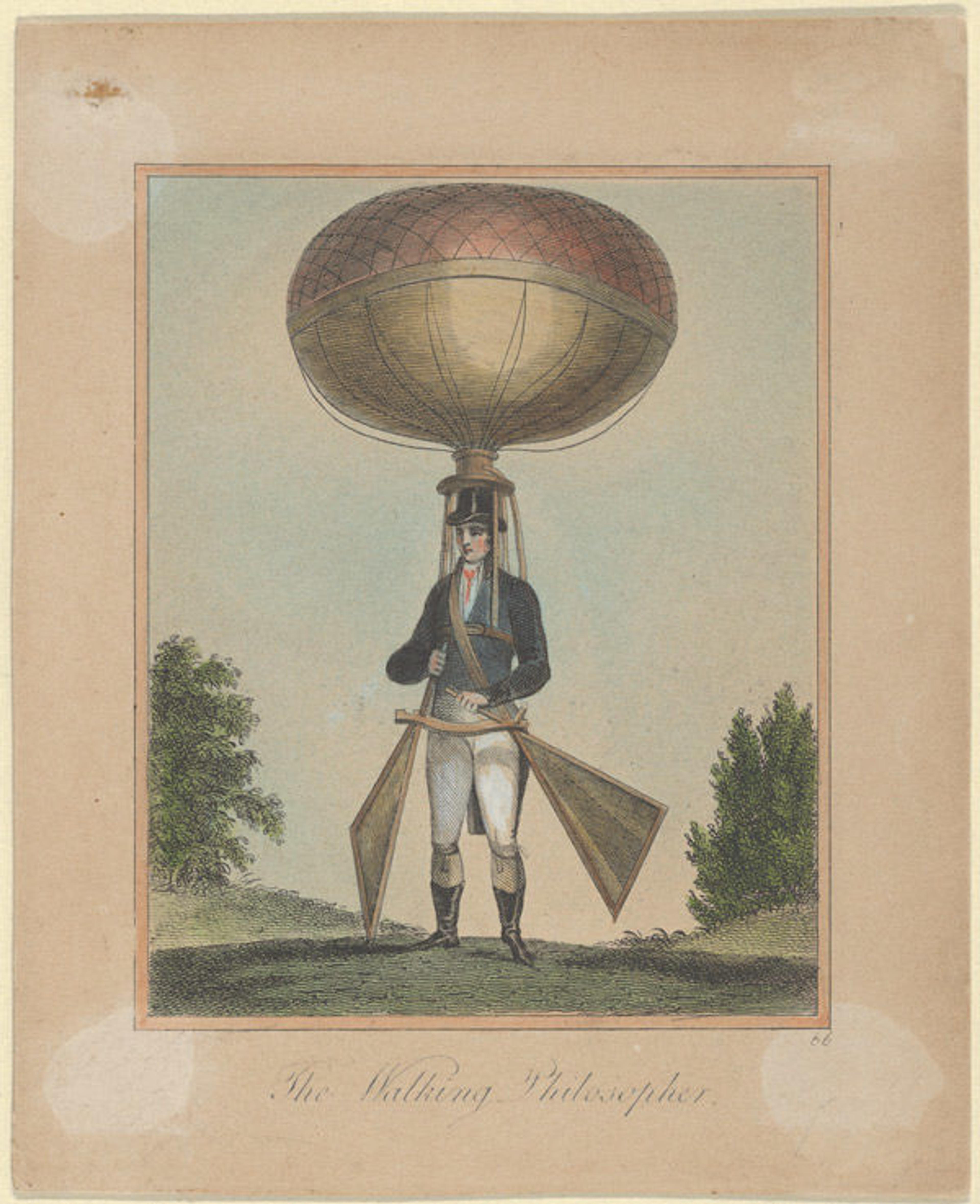
The Walking Philosopher, ca. 1800. Etching with hand coloring, 5 3/8 x 4 1/16 in. (13.6 x 10.3 cm), The Metropolitan Museum of Art, New York, Gift of Paul Bird, Jr., 1962 (62.696.22b)
Another notable print by one of Jung's predecessors is Thomas Rowlandson's Rural Sports: Balloon Hunting. This etching was created in the same spirit as Jung's Bloodless Giraffe Hunt, yet, where Jung makes the pilot the hunter, Rowlandson makes the balloonist the hunted. Rowlandson predicts reactions to early flight in his satire, while Jung suggested a witty use for the still-new flying machine.
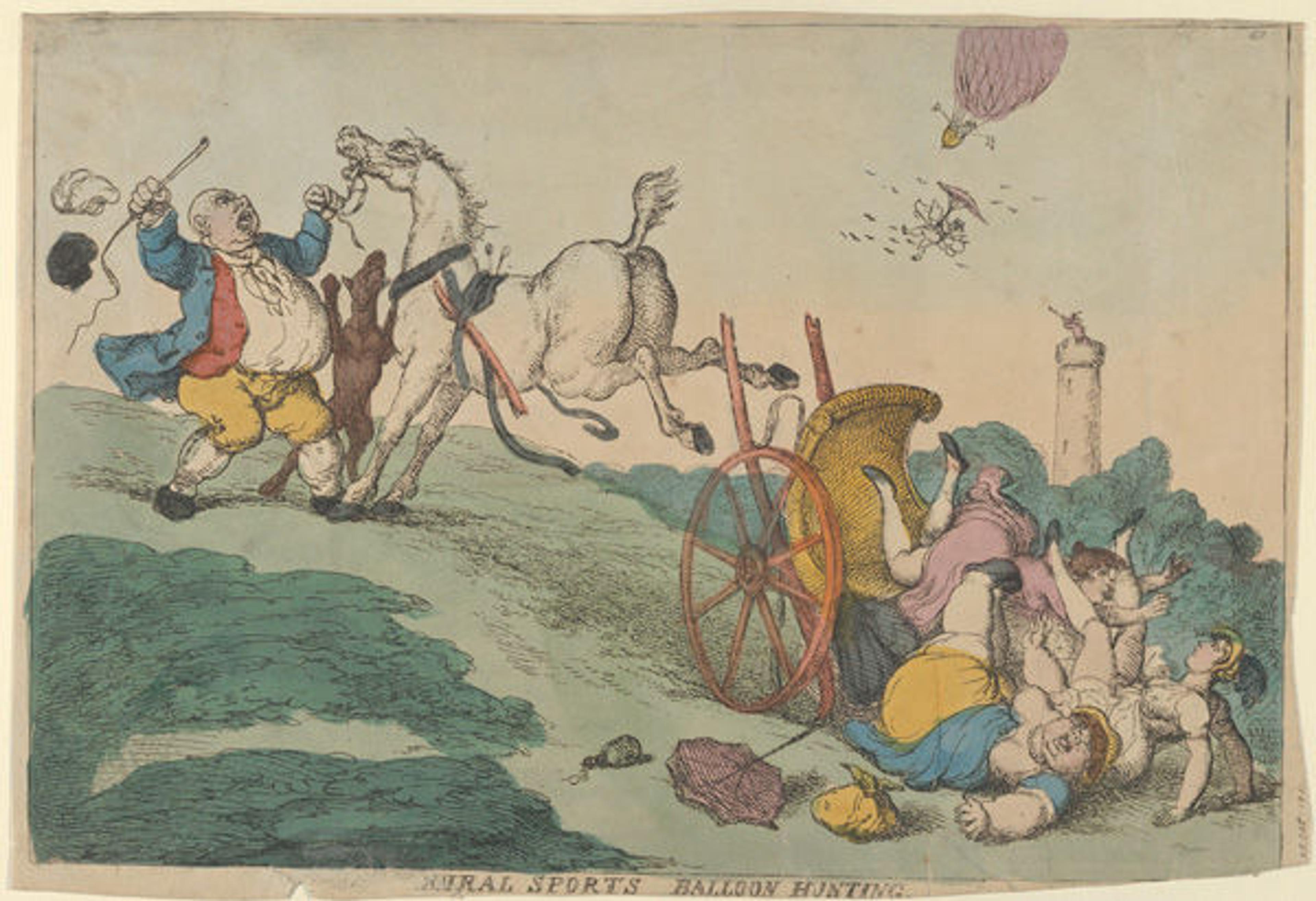
Thomas Rowlandson (British, 1757–1827). Rural Sports: Balloon Hunting, 1811. Etching with hand coloring; 9 1/16 x 13 3/8 in. (23 x 34 cm). The Metropolitan Museum of Art, New York, Gift of Paul Bird, Jr., 1962 (62.696.20)
The Wiener Werkstätte postcards were meant to be shared, traded, and discussed. The fact that Moriz Jung anticipated that a large audience would find his satirical postcards of early flight amusing indicates that there must have been an enthusiastic and good-humored attitude (tinged with some skepticism) toward the new technology of flight in pre-war Vienna.
Theresa Ketterer
Theresa Ketterer was formerly an intern in the Department of Drawings and Prints.